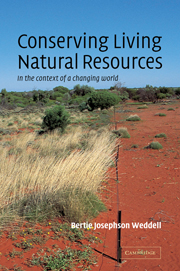Book contents
- Frontmatter
- Contents
- Preface
- Introduction: Balance and flux
- Methodology: Getting the information we need to manage living natural resources
- Part I Management to maximize production of featured species – a utilitarian approach to conservation
- Part II Protection and restoration of populations and habitats – a preservationist approach to conservation
- 7 Historical context – the rise of environmental concerns after World War II
- 8 Central concepts – the causes of extinction
- 9 Techniques – protecting and restoring species
- 10 Techniques – protecting and restoring ecosystems
- Part III Management to maintain processes and structures – a sustainable-ecosystem approach to conservation
- Postscript
- Appendix: Scientific names of organisms mentioned in the text
- Index
10 - Techniques – protecting and restoring ecosystems
Published online by Cambridge University Press: 05 June 2012
- Frontmatter
- Contents
- Preface
- Introduction: Balance and flux
- Methodology: Getting the information we need to manage living natural resources
- Part I Management to maximize production of featured species – a utilitarian approach to conservation
- Part II Protection and restoration of populations and habitats – a preservationist approach to conservation
- 7 Historical context – the rise of environmental concerns after World War II
- 8 Central concepts – the causes of extinction
- 9 Techniques – protecting and restoring species
- 10 Techniques – protecting and restoring ecosystems
- Part III Management to maintain processes and structures – a sustainable-ecosystem approach to conservation
- Postscript
- Appendix: Scientific names of organisms mentioned in the text
- Index
Summary
The preceding chapter explored techniques used by preservationist managers to protect organisms facing extinction. Preservationist management also seeks to protect entire communities, for two reasons. First, these assemblages of interacting organisms are an important facet of biodiversity in their own right. Second, habitat protection potentially offers a means of simultaneously helping large numbers of species more efficiently and effectively than singlespecies conservation efforts. Because of the enormous number of species on earth, many of which have not even been identified, species-based recovery programs cannot, by themselves, save all species. Such programs usually require considerable amounts of effort and funding, and even then success is not guaranteed. Once a population goes into a downward spiral, it is not always possible to save it (for the reasons discussed in Chapter 8).
This chapter describes approaches to protecting and restoring ecosystems. It reviews the history of preserves set aside to protect their natural features, procedures for designing nature reserves to maximize their conservation value, guidelines for identifying sites worthy of protection, and approaches to restoring degraded ecosystems.
Historical background
The terms “preserve” or “reserve” are used quite loosely. Sometimes government owned lands are considered “protected” areas, even though substantial amounts of resource extraction are allowed on public lands.
- Type
- Chapter
- Information
- Conserving Living Natural ResourcesIn the Context of a Changing World, pp. 246 - 276Publisher: Cambridge University PressPrint publication year: 2002



